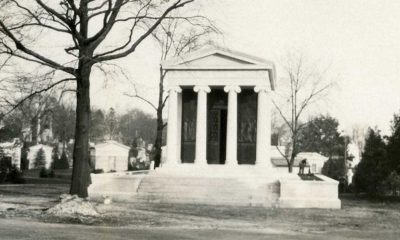Black History
Civil Rights Legend Gloria Richardson’s ‘Eternal’ Struggle
THE AFRO — Gloria Richardson might be better know by her photograph than by her name. A sequence of photographs captured her in Cambridge, 1963, forcing a bayonet out of her face while giving a White National Guardsman the most contemptuous of looks.
By J. K. Schmid
Gloria Richardson might be better know by her photograph than by her name.
A sequence of photographs captured her in Cambridge, 1963, forcing a bayonet out of her face while giving a White National Guardsman the most contemptuous of looks.
Cambridge was under martial law at the time, and tensions were at their peak. Jim Crow was strong in Cambridge. Schools, hospitals and churches were segregated and Black unemployment was quadruple White unemployment.
Richardson nee St. Clair, an heiress of the Baltimore Black elite, was born and raised on Stricker Street until moving to Cambridge at six years old. She attended St. James Episcopal Church and Public School No. 119. She played in Lafayette Park.
“Her family was not middle class, they were actually above middle class,” said Joseph R. Fitzgerald, assistant professor at Cabrini University. “Her family was so wealthy that when Ms. Richardson’s maternal grandfather died, he was a city councilman in Cambridge, Ms. Richardson’s family, they found IOUs where he was lending White politicians money.”
Fitzgerald’s latest work of scholarship is “The Struggle is Eternal: Gloria Richardson and Black Liberation,” what Black Panther Kathleen Cleaver called “the first book to fully examine the Cambridge movement and its leader.”
Cleaver goes on in her critique to describe the now 96-year-old Richardson as a leader “whom the authorities considered almost as dangerous as Martin Luther King Jr.”
And there was real danger. While spokesperson of the Cambridge Nonviolent Action Committee, Richardson nevertheless found herself at the fore of an armed uprising of disenfranchised Blacks, facing off against police, soldiers and White rioters.
The danger was so acute, that Attorney General Robert F. Kennedy was forced to intervene lest neighboring violence spread to the nation’s capital.
Kennedy, representatives of the Department of Justice, the State of Maryland, and local leadership all signed “The Treaty of Cambridge,” a guarantee of civil, economic and human rights for the people of Cambridge. The Civil Rights Act would not be signed into law until the next year.
Businesses, schools and hospitals desegregated over the summer of 1963.
Richardson has told a story of how her uncle died from a White hospital’s neglect when they refused to admit him and save his life.
Cambridge finally elected its first Black and first woman mayor, Victoria Jackson-Stanley, in 2008.
Dion Banks worked on Jackson-Stanley’s 2012 reelection campaign.
“When I talk about reclaiming our narrative, telling our story, one of the things I wanted to do was to make sure that Gloria Richardson was honored,” Banks said at a Red Emma’s book forum and signing with Fitzgerald. “In the state of Maryland you have to be dead in order to get a day declared for you.” Banks and other activists persuaded the Governor’s office to change the rule, but didn’t stop there. “February 11 in the state of Maryland is Gloria Richardson Day, which was the platform that we used to launch what we call Reflections on Pine to tell our story all across the world about Gloria and the Civil Rights Movement in Cambridge.”
Reflections on Pine is a walking tour of Cambridge, a city that historians have described as another-if not the second-Black Wall Street.
“She’s one of the icons who’s not recognized in my opinion, just like Robert Williams, another overlooked figure in the Black liberation movement,” Dr. Ken Morgan, assistant professor Interdisciplinary and Urban Studies at Coppin State University, offered during the forum’s question and answer period. “I just wanted to say that hopefully that, in Maryland at least she should be able to be recognized in the Hall of Fame as a great person who led a great struggle in Maryland.”
“Cambridge, we look at it as a second Black Wall Street, but Cambridge has problems, just like Baltimore City,” Morgan continued, recalling her example and conversations between her and his students. “As well as Salisbury, as well as Prince George’s County, as well as Montgomery County, as well as Frederick County, Hagerstown, other places. It’s going to be really significantly important for Black folks to get together in Maryland to make things happen.
Activism
Oakland Post: Week of April 17 – 23, 2024
The printed Weekly Edition of the Oakland Post: Week of April 17 – 23, 2024

To enlarge your view of this issue, use the slider, magnifying glass icon or full page icon in the lower right corner of the browser window. ![]()
Black History
Matthew Henson: Explorer Extraordinaire
Matthew Henson, a trailblazing explorer who overcame countless obstacles to leave an incredible mark on history. Born on August 8, 1866, in Charles County, Maryland, his journey is a testament to the power of determination and the spirit of adventure.

By Tamara Shiloh
Matthew Henson, a trailblazing explorer who overcame countless obstacles to leave an incredible mark on history. Born on August 8, 1866, in Charles County, Maryland, his journey is a testament to the power of determination and the spirit of adventure.
Henson’s life began amidst the backdrop of post-Civil War America, where opportunities for African Americans were scarce. From a young age, he possessed an insatiable curiosity about the world beyond his small town. At the age of 12, he embarked on a journey that would change the course of his life forever when he joined a merchant ship as a cabin boy.
His most famous expedition was his journey to the Arctic with renowned explorer Robert E. Peary. In 1887, Henson joined Peary’s crew as a seaman and quickly proved himself to be invaluable with his skills as a navigator and craftsman. Over the course of several expeditions, Matthew endured extreme cold, treacherous terrain, and grueling conditions as he and Peary sought to reach the elusive North Pole.
In 1908–09, Peary set out on his eighth attempt to reach the North Pole. It was a big expedition, with Peary planning to leave supplies along the way. When he and Henson boarded their ship, the Roosevelt, leaving Greenland on August 18, 1909, they were joined by a large group. This included 22 Inuit men, 17 Inuit women, 10 children, 246 dogs, 70 tons of whale meat, blubber from 50 walruses, hunting gear, and tons of coal.
In February, Henson and Peary left their anchored ship at Ellesmere Island’s Cape Sheridan, along with the Inuit men and 130 dogs. They worked together to set up a trail and supplies along the way to the Pole.
Peary picked Henson and four Inuit people to join him in the final push to the Pole. However, before they reached their destination, Peary couldn’t walk anymore and had to ride in a dog sled. He sent Henson ahead to scout the way. In a later interview with a newspaper, Henson recalled being in the lead and realizing they had gone too far. The group turned back, and Henson noticed his footprints helped guide them to their destination. At that location, Henson planted the American flag.
Henson’s legacy extends far beyond his expeditions to the Arctic. He shattered racial barriers in the world of exploration and inspired countless individuals, regardless of race, to dream big and pursue their passions. In 1937, he was finally recognized for his achievements when he was inducted into The Explorers Club, an organization dedicated to promoting scientific exploration and field research.
Matthew Henson died in the Bronx, New York, on March 9, 1955, at the age of 88.
Art
Marin County: A Snapshot of California’s Black History Is on Display
The Marin County Office of Education, located at 1111 Las Gallinas Ave in San Rafael, will host the extraordinary exhibit, “The Legacy of Marin City: A California Black History Story (1942-1960),” from Feb. 1 to May 31, 2024. The interactive, historical, and immersive exhibit featuring memorabilia from Black shipyard workers who migrated from the South to the West Coast to work at the Marinship shipyard will provide an enriching experience for students and school staff. Community organizations will also be invited to tour the exhibit.

By Post Staff
The Marin County Office of Education, located at 1111 Las Gallinas Ave in San Rafael, will host the extraordinary exhibit, “The Legacy of Marin City: A California Black History Story (1942-1960),” from Feb. 1 to May 31, 2024.
The interactive, historical, and immersive exhibit featuring memorabilia from Black shipyard workers who migrated from the South to the West Coast to work at the Marinship shipyard will provide an enriching experience for students and school staff. Community organizations will also be invited to tour the exhibit.
All will have the opportunity to visit and be guided by its curator Felecia Gaston.
The exhibit will include photographs, articles and artifacts about the Black experience in Marin City from 1942 to 1960 from the Felecia Gaston Collection, the Anne T. Kent California Room Collection, The Ruth Marion and Pirkle Jones Collection, The Bancroft Library, and the Daniel Ruark Collection.
It also features contemporary original artwork by Chuck D of the Rock and Roll Hall of Fame group Public Enemy, clay sculptures by San Francisco-based artist Kaytea Petro, and art pieces made by Marin City youth in collaboration with Lynn Sondag, Associate Professor of Art at Dominican University of California.
The exhibit explores how Marin City residents endured housing inequities over the years and captures the history of plans to remove Black residents from the area after World War II. Throughout, it embodies the spirit of survival and endurance that emboldened the people who made Marin City home.
Felecia Gaston is the author of the commemorative book, ‘A Brand New Start…This is Home: The Story of World War II Marinship and the Legacy of Marin City.’ Thanks to the generous contribution of benefactors, a set of Felecia’s book will be placed in every public elementary, middle, and high school library in Marin.
In addition, educators and librarians at each school will have the opportunity to engage with Felecia in a review of best practices for utilizing the valuable primary sources within the book.
“Our goal is to provide students with the opportunity to learn from these significant and historical contributions to Marin County, California, and the United States,” said John Carroll, Marin County Superintendent of Schools.
“By engaging with Felecia’s book and then visiting the exhibit, students will be able to further connect their knowledge and gain a deeper understanding of this significant historical period,” Carroll continued.
Felecia Gaston adds, “The Marin County Office of Education’s decision to bring the Marin City Historical Traveling Exhibit and publication, ‘A Brand New Start…This is Home’ to young students is intentional and plays a substantial role in the educational world. It is imperative that our community knows the contributions of Marin City Black residents to Marin County. Our youth are best placed to lead this transformation.”
The Marin County Office of Education will host an Open House Reception of the exhibit’s debut on Feb. 1 from 4 p.m. – 6 p.m.. All school staff, educators, librarians, and community members are encouraged to attend to preview the exhibit and connect with Felecia Gaston. To contact Gaston, email MarinCityLegacy@marinschools.org
-

 Activism4 weeks ago
Activism4 weeks agoOakland Post: Week of March 27 – April 2, 2024
-

 #NNPA BlackPress4 weeks ago
#NNPA BlackPress4 weeks agoCOMMENTARY: D.C. Crime Bill Fails to Address Root Causes of Violence and Incarceration
-

 #NNPA BlackPress4 weeks ago
#NNPA BlackPress4 weeks agoFrom Raids to Revelations: The Dark Turn in Sean ‘Diddy’ Combs’ Saga
-

 #NNPA BlackPress4 weeks ago
#NNPA BlackPress4 weeks agoCOMMENTARY: Lady Day and The Lights!
-

 #NNPA BlackPress4 weeks ago
#NNPA BlackPress4 weeks agoMayor, City Council President React to May 31 Closing of Birmingham-Southern College
-

 #NNPA BlackPress4 weeks ago
#NNPA BlackPress4 weeks agoBaltimore Key Bridge Catastrophe: A City’s Heartbreak and a Nation’s Alarm
-

 #NNPA BlackPress4 weeks ago
#NNPA BlackPress4 weeks agoBaltimore’s Key Bridge Struck by Ship, Collapses into Water
-

 #NNPA BlackPress4 weeks ago
#NNPA BlackPress4 weeks agoBeloved Actor and Activist Louis Cameron Gossett Jr. Dies at 87

















































